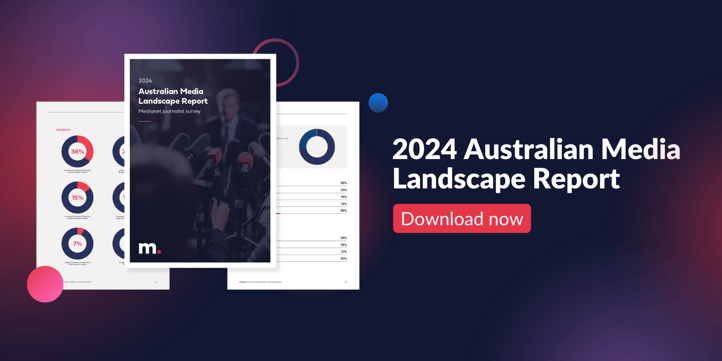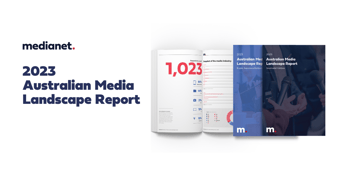2024 Media Landscape Report: Journalists concerned about impact of generative AI on their work and jobs.
Generative AI was a major focus of the 2024 Australian Media Landscape Report released today - with findings revealing major concerns from journalists about what it could mean for the quality of their work and their livelihoods.
Based on a survey of more than 800 Australian journalists, the report revealed that while most journalists (74%) had not yet personally used generative AI in their work and 19% were not aware of how AI is being used in their newsrooms, 67% of respondents believed that generative AI could potentially replace aspects of their jobs. Further, twelve percent of respondents claimed to know someone who has lost work or lost work themselves due to the uptake of generative AI in 2023.
Medianet Managing Director, Amrita Sidhu, said that the heightened fear from journalists could stem from the lack of awareness about how AI is being used in newsrooms and its potential impact on journalistic integrity.
While most journalists (74%) had not yet personally used generative AI in their work and 19% were not aware of how AI is being used in their newsrooms, 67% of respondents believed that generative AI could potentially replace aspects of their jobs.
"The introduction of generative AI has sparked concerns among journalists, but it's essential to bridge the gap between concerns and real-world impact," Sidhu said.
“While the figure is quite small, it is concerning that some journalists had already lost work despite the relatively low uptake of AI in the media so far.”
The report also shows findings on journalists' average salaries, once again highlighting gender pay gaps in the media industry.
From the findings, journalists have not been immune to cost-of-living challenges. ‘Money’ was identified as the greatest challenge of 43% of respondents in 2023, while 67% felt they were underpaid. Conversely, female journalists earning over $100,000 increased by 7% from the previous year.
In a year where the platform formerly known as Twitter received significant publicity following the company’s acquisition by Elon Musk and subsequent rebrand to X, there was a significant drop in professional Twitter/X usage in 2023.
The platform dropped from being the second most used social media platform for journalists in 2022 to being the fourth most-used platform, after Facebook, Instagram and LinkedIn. Fifty-eight percent of respondents said they used Twitter/X in 2023 down from 69% in 2022. Ten percent identified having either recently deleted their account or stopped using it in 2023. A quarter of respondents (26%) said they still had an account but rarely used Twitter/X for professional purposes in 2023.
Journalists disclosed their main motivations to report on stories, with 80% stating their primary motivation is to inform the public accurately and fairly.
“This comprehensive report underscores the industry's commitment to principled reporting, the need for public understanding, and the continued importance of accurate and impartial journalism,” Sidhu said.
The key findings
Journalists and generative AI
-
74% of journalists had not personally used generative AI/LLMs in their work.
-
79% of respondents said they were concerned about the impacts that generative AI/LLMs could have on the overall integrity or quality
-
36% believe that AI is a threat to public journalism
-
67% of respondents said they believed that generative AI/LLMs could potentially replace aspects of their jobs
-
12% of respondents know someone who has lost work or lost work themselves
-
From the 25% of respondents that claimed to have used generative AI in their journalism work, those working in podcasting had by far the highest update of AI/LLMs professionally (38% of podcasters had used it).
Gender
-
The percentage of respondents who were paid over $100,000 per year increased from 25% to 31% in 2023. These results are not adjusted for inflation, and do not account for respondents’ employment types, for example part-time compared to full-time.
-
38% of male journalists earn more than $100,000 compared to 27% of women and 14% that identify as non-binary.
-
Female journalists earning over $100,000 increased by 7% from the previous year (20% in 2022, 27% in 2023) but the gap between female and male journalists remained at 11%
-
Despite holding more precarious positions and being paid less, women do not feel as underpaid as men.
-
Just 21% of women who feel underpaid earn more than $100,000 p.a and 41% working are on a part time, casual, freelance or contract basis.
-
31% of men who feel underpaid earn more than $100,000 p.a. Of these respondents, 70% are in full-time employment while only a third work on a part time, casual, freelance or contract basis.
Perception of Journalism
-
A very significant proportion of journalists (approximately 45%) said they wished the public understood that their work is driven by genuinely good intentions and ethics to report accurately and fairly, and the media is not operating under some ideological agenda or ‘conspiracy’.
-
80% of respondents said their main motivation to report on stories is informing the public.
-
95% of journalists said they have never lied to a source to get information.
Employment and challenges
-
66% of respondents felt they were underpaid in 2023.
-
43% said ‘money’ was their greatest challenge. This is significantly higher than 2022 when 32% mentioned ‘money’ as their biggest challenge. Money has consistently been journalists biggest challenge for three years in a row and on the rise.
-
Journalists working in TV and podcasts are highest paid on average
-
There was an increase of journalists working in Print (44% to 49% in 2023). While the survey showed a lift in respondents working in print media compared with last year’s results, print media had the most insecure workforce across all media types.
Public Interest Journalism and Defamation
-
70% of journalists identified ‘increase in disinformation/fake news’ as the biggest threat to public interest journalism in 2023, followed by ‘lack of resources and staff’.
-
21% of journalists said the outcome of high profile defamation cases in 2023 had impacted their journalism work. The majority of respondents (65%) said it had not affected their journalism work.
-
Journalists working for publicly/ government funded media organisations reported the highest rates of being affected by the outcomes of these defamation cases, both positively and negatively. Respondents reporting on politics or religion reported the highest rates of being affected by the outcomes of these cases. This was followed by those working in the topic of courts and crimes, international news or foreign affairs, Indigenous affairs or national news.
Diversity and inclusion
-
41% of respondents said there were workplace policies in place at their media organisations to increase diversity and representation.
-
Of those who said there were policies in place, 78% said they believed their media organisation was effective in upholding them, and 13% said the policies were not effectively upheld.
Professional use of social media
-
96% of respondents have used social media in their media work in 2023.
-
Facebook continued to be the most commonly used platform by journalists professionally in 2023.
-
76% of respondents said they use Facebook professionally.
-
Usage of Twitter/X dropped two spots in one year and is now on the fourth most used professionally by journalists (58% of journalists in 2023 vs 69% in 2022). It is now replaced by Instagram (67%) and closely followed by LinkedIn (60%).
-
Tiktok has increased 6% in just one year, Twitter/X has decreased by 11% in a year.
-
Journalist sources
-
-
86% of journalists indicated that industry and professional contacts were the top story sources for 2023
-
81% of journalists use press releases as a story source
-
75% of journalists said they use Search Engines as a source
-
73% of journalist’ said they used social media as a story source (compared to 76% in 2022)
-
Press releases/pitches
On where journalists get their get pitches from:
-
89% of journalists said their PR contacts email them directly with press releases.
-
67% said they receive emails or pitches from a press release distribution service.
On how likely it is a journalist will covering a story that has already been covered:
-
47% of survey respondents said they were less likely to cover a story that had already been covered by another media Organisation.
-
Podcasting was least likely to cover a story that had already been reported (57% of those that said ‘less likely’ worked in Podcasting).
-
Print was more likely to cover a story that had already been reported (14% of those who said ‘More likely’ worked in Print).
-
On how journalists use the press releases they pick up:
-
55% said they tend to write or produce the story themselves using some information from the release.
-
29% said they use the release as background information only.
-
13% said they use the information on the release for most of the story.
On how journalist think is best to build relationships between journalists and PR:
-
62% said by providing story/interview exclusives.
-
61% said by sending personalised story pitches.
-
48% said by sending press releases.
-
45% said to only contact when necessary.
Read the full report here.
In addition to the journalist survey results, Medianet is also providing a PR Guide for Effective Media Engagement with learnings for PR professionals from surveys from 2020 to 2023. The guide can be found here.
No time to read the full report? Join us on February 15th when we will discuss the findings of the report along insiders of the PR and Media industries. Learn more here.
About the Author

Mercedes Carrin
Mercedes is passionate about purpose-led marketing initiatives that help businesses and their audience build relationships. Over more than 15 years she has executed effective marketing campaigns within the media, advertising and public relations industries leveraging the power of storytelling, technology and data. Based in Sydney, Mercedes was formerly Marketing Manager at Australian Associated Press (AAP) which has given her a unique perspective of the Australian and New Zealand media landscape.





